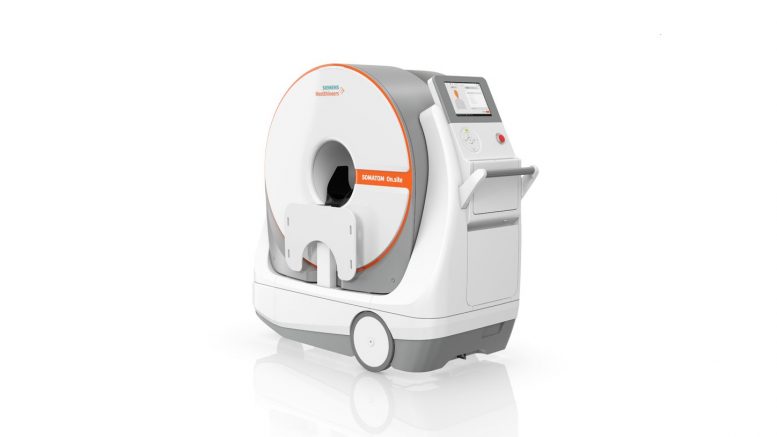Technological advances, the need to level-up access to services, and a new willingness to do things out of hospital might now see the NHS rapidly and permanently un-constrain the geography of its diagnostic services, write Jane Rendall and Rachel Dunscombe.
If you need a scan, then you go to hospital. For many people, that has been the norm of their NHS experience.
But all of the signs are pointing to a different model becoming the norm very quickly – with safer, sustainable, convenient and fairer ways of delivering and accessing diagnostic services.
Scans in vans, algorithms and 5G
Barcelona’s Mobile World Congress, held in June and July this year, demonstrated just some of the art of the possible with the presence of CT scanners that fit in a van, costing a fraction of traditional devices, and that use algorithms to enhance images.
External factors, such as the growing availability of 5G are also a game changer in delivering higher bandwidth and higher reliability. This opens new possibilities around the mobility of services into the community, as well as overcoming network challenges faced in hospitals themselves. Research and discussion are even happening around 6G, a conversation in which healthcare leaders are already being encouraged to engage in order to voice their likely requirements.
Technology is continuing to change in ways that might continue to support mobile diagnostics. Pill sized cameras now exist that can be used to carry out endoscopies, for example. And AI advances might mean that in the near future, technology itself could make decisions on which bits of an image to store or transmit, avoiding the need to consume mobile bandwidth with unhelpful information and preventing data overload in a patient’s longitudinal record.
This is about distributing where work is done, and bringing in the intelligence at the right point so that we don’t send very large messages everywhere.
Moving models away from big buildings
Until very recently the vision around service provision, and the supporting infrastructure, has been to equip big buildings with tech and bring everyone into that one place.
That model is now changing. Some European countries are exploring how to ensure 90% of people are no more than eight minutes away from certain diagnostics, whilst high street pharmacies in parts of the continent are transforming beauty and what were cosmetic counters into places that can acquire diagnostic images.
Things are changing within the UK too. The COVID-19 pandemic has stimulated plans from NHS England to create community diagnostic hubs – one stop shops, close to people’s homes, where they can receive “life changing checks”. Support from visionary trust leaders to deliver x-rays on your high street is also emerging in the media.
Community diagnostic centres could have a big impact for people who have had poor access to healthcare for various reasons – whether that’s not being able to afford to travel to a hospital, not being able to take time off work, or finding it physically challenging. In some cases this inequity in access extends to areas you might not expect. For instance, in some urban areas younger people have been cautious about leaving their housing estate to engage with healthcare because of gangs. Bringing health services and diagnostics to these communities in vans has been shown to improve uptake.
The COVID crisis has too demonstrated the importance of availability of community testing, with millions of people taking advantage of testing in their home or at satellite sites nearby.
Community diagnostic services by default
We have learned that distribution can be a good thing. If we think about smaller scanners, and the potential to allow people to book their own appointments in a place convenient to them – we can better serve the needs of communities.
We need to start to think about community diagnostic services not as the exception for dealing with public health emergencies, or to support limited clinical scenarios, but as the default.
Such an approach can help the NHS to meet some of the fundamental requirements of its own constitution, whether that’s delivering “a comprehensive service, available to all” or basing access on clinical need.
Moving services nearer to people makes it easier to access for all sorts of groups. This is an opportunity to democratise access and taking away health inequalities, whilst addressing challenges around infection control and the prevention of hospital acquired illnesses.
And as the NHS green agenda advances to reach net zero by 2040, reducing the need for millions of journeys to hospital will make a big difference – both in reaching the target and in directly reducing ill-health.
The responsibility of everyone
For this to work, we need to change our governance and embrace opportunities to innovate.
This is about examining those frontiers of science and technologies that can make positive changes in patient care. Organisations need to make their boards and chief executives interested in the subject matter.
Indeed, everyone who works in healthcare might ask what this means for them. Places in healthcare that do this well will be able to re-orientate people, develop organisationally, create new career pathways for clinicians and stimulate awareness for how patients can interact with services.
This is about system change. And it is about taking lessons from COVID about how we deliver radical change in the delivery of services where people have willingly already made a seismic shift in ways that often work better for patients, professionals and providers.
About the Authors
Rachel Dunscombe is a director for Tektology and Jane Rendall is UK managing director for Sectra





